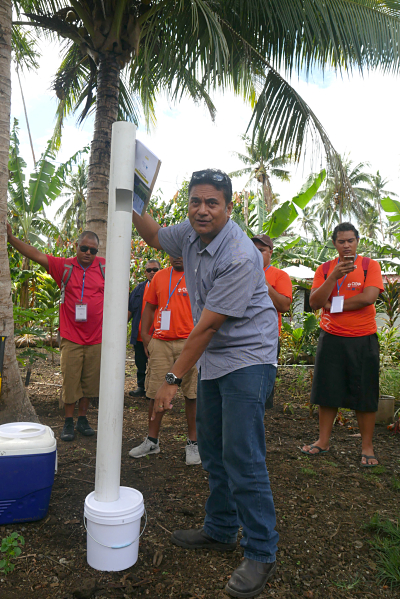


Thanks to education and outreach on the invasive species, Rota was prepared to trap the beetles and sanitize the area to prevent the spread, Quitugua said. Quitugua said there's a strong possibility that the beetles came from Guam, but scientists will be sending samples off-island to determine whether it's the same biotype.

Guam's specific biotype of coconut rhinoceros beetles are known to be difficult to exterminate. The insects have devastated Guam's iconic coconut trees by eating at its core and forming breeding sites within them. Guam has been plagued with the beetles for a decade. "For them, it's not a matter of if something is coming, but when," Quitugua said. Rota and the rest of the Commonwealth of the Mariana Islands have been vigilant in watching out for this species, especially since the islands lie close to Guam. "Because it was found in one small spot, the beetles won't bother Rota," Quitugua said. Department of Agriculture's Animal and Plant Health Inspection Service on Guam, and UOG for analysis. The invasive species were found Thursday and have since been removed and sent to the U.S. Roland Quitugua, University of Guam extension and outreach agent, said it is Rota's first case of a coconut rhinoceros beetle population on the island. Twenty-four coconut rhinoceros beetles and about 300 beetle larvae have been found near a Rota seaport. Our R&D team will continue to research on this fungus as a biological pesticide on other destructive insects and other crops.Watch Video: Top invasive species of Guam These promising results show that Metarhizium anisopleae can be used to control other insect pests. This treatment is least effective on grasshoppers with a result of 12% insect mortality rate.

The highest success rate against the army worms is at 66,7% at the concentration of 2% Metarhizium anisopleae fungus. On scale insects, application of Metarhizium anisopleae fungus at 1,5% is almost 100% effective. Our findings show very promising results. Indmira R&D division has carried studies on the effect of Metarhizium anisopleae as a biological pesticide in controlling the populations of important insect pests, such as scale insects ( Phenacoccus manihoti), army worms ( Spodoptera spp.), rice ear bug ( Leptocorisa oratoria), and grasshoppers (Caelifera). Metarhizium anisopliae can then be purified and applied to crops to prevent and/or eradicate Oryctes rhinoceros. This can be achieved by initially growing Metarhizium anisopliae on a potato dextrose agar (PDA) then increasing the production in the potato dextrose extract solution. To utilize this fungus, we must first be able to produce a large amount of pure isolates. Recent findings show that Metarhizium anisopliae application can effectively fill the role of curbing coconut beetle infestation.įound in the soil, Metarhizium anisopliae causes diseases in insects by acting as a parasite. However, these treatments have not shown significant impacts in controlling Oryctes rhinoceros damages in the fields. Such beetle infestation has been controlled by cultivation methods, chemicals, as well as biological agents. These damages lead to reduced production and even death of the plants. Plant damage is caused by adult insects that consume the growing parts. At larval stage, this insect consumes dead wood materials. This insect goes through a complete metamorphosis, which involves stages of eggs, larvae, pupae, and adults. Despite the name, this insect causes damages in other important economic plants such as cassava, sugarcane, oil palm, and other palm species. Oryctes rhinoceros, also known as Asian coconut beetle, is an important pest in this part of the world.


 0 kommentar(er)
0 kommentar(er)
